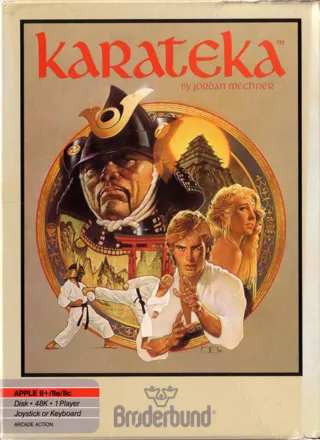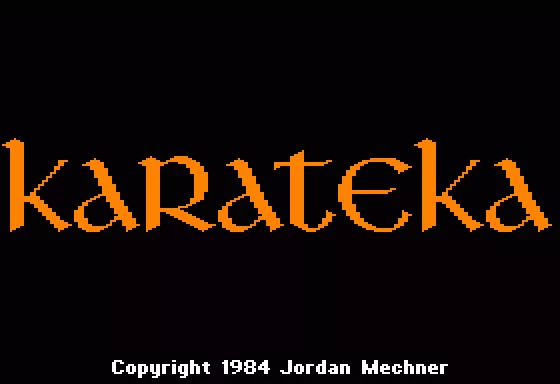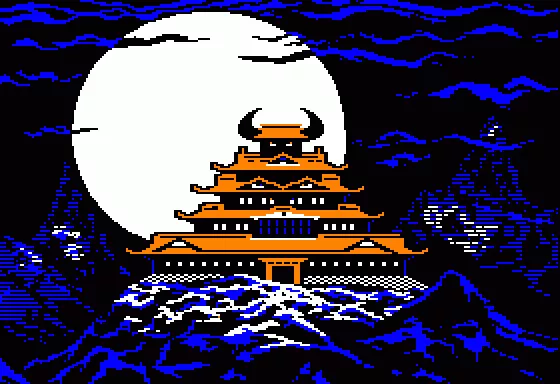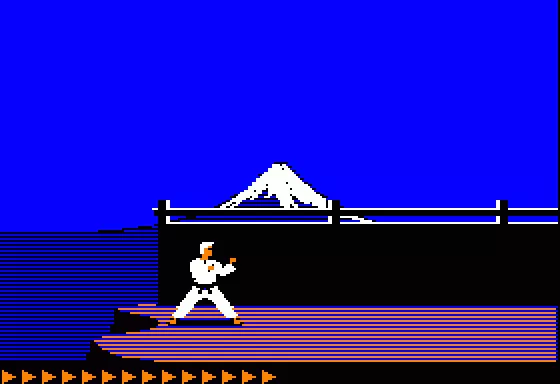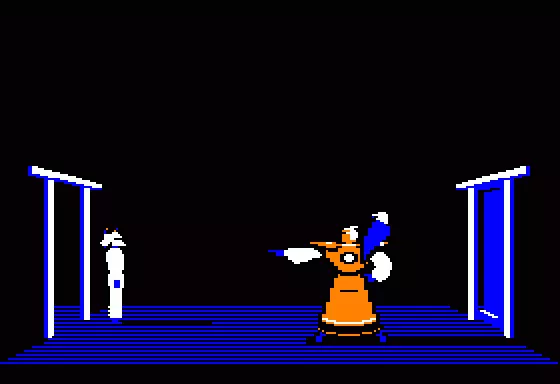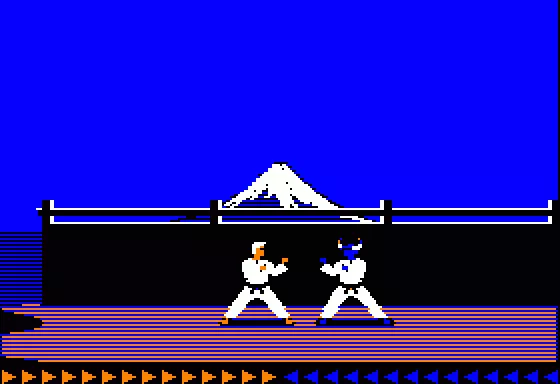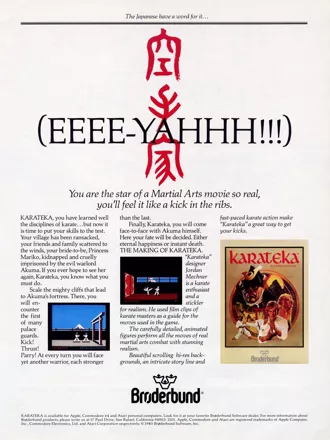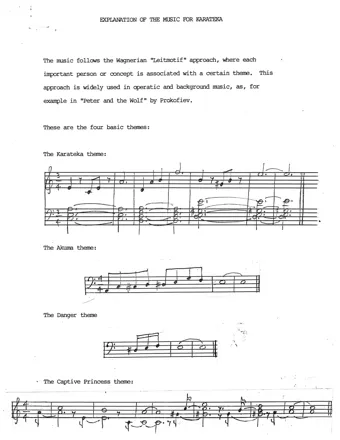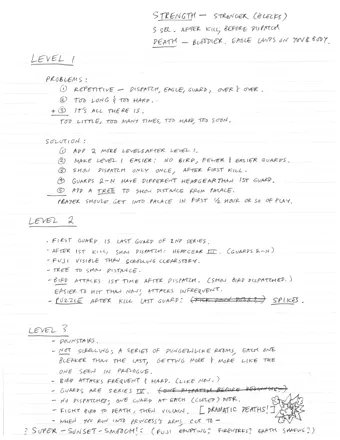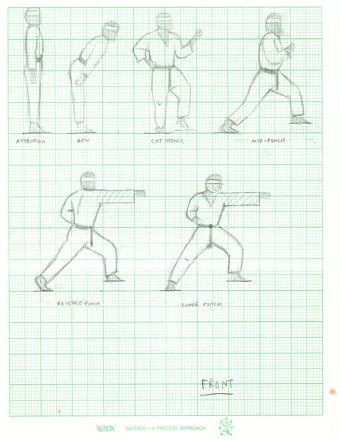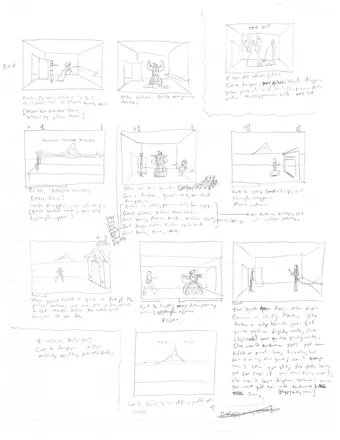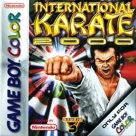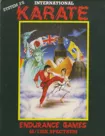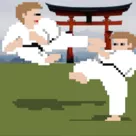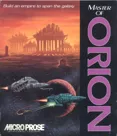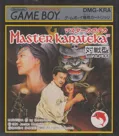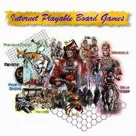Karateka
-
 Karateka
(2012 on
Xbox 360,
Windows,
iPad...)
Karateka
(2012 on
Xbox 360,
Windows,
iPad...)
Description official descriptions
The evil Akuma has destroyed the protagonist's homeland, killed many of his friends and kidnapped the princess Mariko. Fortunately, the hero is skilled in martial arts, so his inevitable quest to reach Akuma's palace and rescue Mariko has a chance of success.
Karateka is viewed from the side and features a succession of increasingly difficult opponents. Three types of punches and kicks are available to both the player character and his foes, differentiated by their height (low, medium, and high). The protagonist has a health bar, which refills itself gradually when he stands still.
Spellings
- カラテカ - Japanese spelling
Groups +
Screenshots
Promos
Credits (Apple II version)
| Creator | |
| Additional graphics and animation |
Reviews
Critics
Average score: 75% (based on 11 ratings)
Players
Average score: 3.7 out of 5 (based on 128 ratings with 5 reviews)
A classic that demonstrates how well a story can be told with no words.
The Good
The finest aspect of Karateka, and one that hasn't lost anything due to the game's age was how well Jordan Mechner could tell a tale with nothing but visuals and musical cues. There is no dialogue, not even text. Characters merely make gestures and the music plays their mood so wonderfully that one knows what the characters are 'saying' without hearing/seeing a single world. It's brilliant and such an achievement has only been achieved a few times in the history of gaming.
For their time frame, the graphics were well done. Crisp, clean, and effective, they were exceptional for when the game came out.
At the time, the basic concept (running down the hall fighting opponents in a very simplified fighting game style) was enjoyably fresh.
The Bad
The gameplay is very repetitive, as you face off against tone lackey after another with minimal to no difference between emplyess.
The fighting style, an early fighting game type of engagement, lacks finesse or true style. You more times than not wind up just mashing buttons until you connect...often using the same maneuver again and again in rapid succession. Aside from a few surprises (like Akuma's falcons attacking), there's little difference between your opponents or how you fight them.
The difficulty level, mixed with the controls and repetitiveness, might scare away many poeple who will find this game somwhat hard and frustrating.
The Bottom Line
An early side-scrolling fighting/action game, Karateka is a classic in the way it tells its story. The game's simplicity is both its charm and its downfall.
DOS · by Ray Soderlund (3501) · 2000
Do you hear the grasshopper at your feet?
The Good
Karateka wasn't the first martial arts game for the Commodore 64 (and yes, I know it didn't originate here), but it didn't borrow much from its predecessors. Unlike the acrobatic Yie Ar Kung-Fu fighting game, the arcade platformer Bruce Lee, or the Game of Death-like Kung Fu Master, Karateka—at first glance—was a conventional "run to the right" game.
The evil Akuma has captured Princess Mariko. He holds her in a cell, deep within his mountain fortress. Only the Karateka, the trained master of empty handed fighting, can rescue her. To do this, he'll have to fight his way through Akuma's henchmen, heading deeper and deeper into the heart of the fortress. There are no extra lives here, no save points, no continues—just one chance to save the princess.
After hoisting himself over the edge of a cliff, the Karateka began his run to the right and encountered his first enemy. If he didn't switch from running to his fighting stance, it would also be his last enemy because the enemy would kill him with one blow. Encountering his first enemy, the Karateka noticed the enemy's life bar. At this point they were equally matched—later enemies would have lifebars much longer than the Karateka's.
Then combat commenced. The Karateka's attacks were limited: High Punch, Medium Punch, Low Punch and High Kick, Medium Kick, and Low Kick. He could punch indefinitely, but could only perform three kicks in a row. For the most part this matched his opponents, but some could string more kicks together and his opponents' timing could differ than his. What became more important than being able to strike, was knowing when to strike. The Karateka could retreat half a step and then hammer into the enemy as he approached or take a full step forward and add a High Kick on to it knocking his enemy back a step. If he was low on health, he could retreat a bit and recover some energy, but if he didn't press the attack, the enemy would heal too.
After defeating one opponent it was on to the next—but there were some surprises too: a door that couldn't be trusted, Akuma's avian attack, and knowing when to bow.
Karateka had very good graphics, including very fluid combat animations and rewarding "hits". What set this apart from other games were intermittent cutscenes showing Akuma issuing orders and what was happening to the princess. Sound and music were phenomenal, really providing the game with a mood.
The Bad
There's the old joke about Tai Chi being a great martial art to know if you are ever fighting in slow motion. Combat in Karateka isn't that slow, but it is at a regular pace which can thwart one's intention to get through the game by mashing buttons. Its insistence on standard punching and kicking seems to place an odd emphasis on realism, one that some gamers felt was too limiting. And to be honest, there's something to the more visceral games like 1985's Way of the Exploding Fist.
Karateka's one life, one chance motif became a little nerve wracking, especially when you learned there were a few sneaky ways to die—instantly. Granted, I don't know what save schemes were in place at the time, but something to give the player a breather would have been nice.
The Bottom Line
Karateka is a great old-school game that serves as a bridge between classic gaming and the games of today. It was a standard platformer with style, meant to be played in one sitting, with great animation and gameplay that kept moving forward.
Commodore 64 · by Terrence Bosky (5398) · 2004
The Good
There is a lot of action, the movements are very flexible.
This game is a classic, I like the story, concept, and animations.
The sounds are very good for a 1986 game.
The Bad
Poor graphics, unappealing game play.
The Bottom Line
Definitely a game to buy.
The fighting in the game is very slow, so if you are expecting an old fashioned Street Fighter, I'm sorry.
This game is a good game overall.
DOS · by Jim Fun (207) · 2001
Discussion
| Subject | By | Date |
|---|---|---|
| Hercules Incolor support | Pix (1172) | Apr 11th, 2023 |
Trivia
Akuma
"Akuma'", the name of the evil warlord in Karateka (and many other games featuring a Japanese bad guy), is a Japanese word that roughly means 'devil'.
Akuma Castle
The Akuma Castle that appears at the beginning, seems to be inspired by the "Himeji Castle" that really exists in Japan, near Kyoto. Search on Google or Altavista Image Search for "Himeji Castle" and you'll find pictures of the real castle.
Android and iOS versions
The Android and iOS versions runs on the Apple II GS emulator ActiveGS.
Apple II version
The Apple II version of Karateka came on one single-sided floppy disk. However, by booting Karateka up on the opposite side (Side Two) - the game would still load, but now the game was upside down. A visual gag on the part of someone at Brøderbund most likely.
Atari 7800 version
For the Atari 7800 version of Karateka, the end label on the cartridge was unusual in that it featured square corners instead of the usual rounded corners. This was one of the only (if not the only) games to do so.
Cliff
It is possible to fall off the edge of the cliff in the first scene if you back into it.
Engine
The game's engine would be later used in Prince of Persia.
Text files
Most of Karateka on the PC is made of editable text files. You can modify the game by changing the coordinates in the language files.
Title
"Karateka" means a practitioner of karate.
Hidden Text
The Atari 7800 version contains a hidden message at hexadecimal address 0x079D, which reads "MOMMY AND ME ARE ONE". This refers to a 1985 study on subliminal messages by Lloyd Silverman and Joel Weinberger, in which a near-identical phrase was supposedly found to have a positive effect on subjects' self-motivation.
Awards
- Happy Computer
- Issue 02/1986 - #10 Best Game in 1985 (Readers' Vote)
Information als contributed by Coltrane, James1, Macintrash, Maw, Michael Palomino, Ray Soderlund and Servo
Analytics
Identifiers +
Contribute
Are you familiar with this game? Help document and preserve this entry in video game history! If your contribution is approved, you will earn points and be credited as a contributor.
Contributors to this Entry
Game added by rcoltrane.
Commodore 64 added by Quapil. Apple II added by KnockStump. ZX Spectrum, Atari 8-bit, Android, iPhone, iPad, Palm OS added by Kabushi. Atari ST, Amstrad CPC added by Martin Smith. NES added by Bregalad. MSX added by Terok Nor. Atari 7800 added by Servo. PC-98 added by Unicorn Lynx.
Additional contributors: Trixter, Kabushi, Martin Smith, Patrick Bregger, Starbuck the Third, Rik Hideto, Harmony♡.
Game added April 3rd, 2000. Last modified December 30th, 2023.
